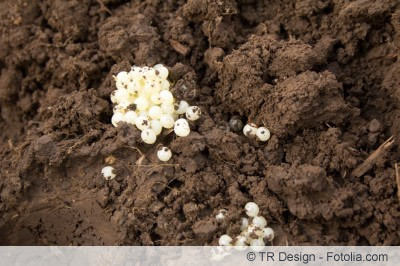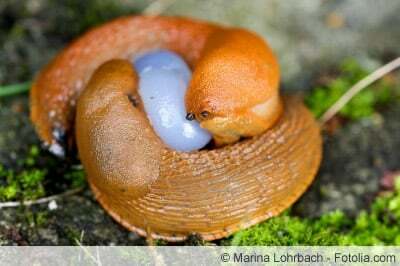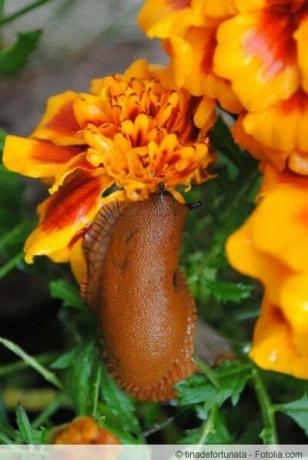

Table of contents
- Effective biological means against snails
- alum water
- Begonia manure
- Fern manure
- currant leaf extract
- Coffee
- compost manure
- liverwort extract
- moss manure
- Rhubarb Leaf Manure
- Pinecone manure
- Tomato shoot manure
- Vermouth manure
- Natural enemies
- Mechanical snail defense
- Relaxed gardeners are not necessarily anti-snails
- “steer” snails
- Anti-slug plants
- Snail Attractant
- Why "only" biological means?
Many biological agents help against snails; often at the same time leftovers and fertiliser/strengthening agent for the plants. An exciting step that also leads towards an ecologically self-regulating garden and household cycle with little waste:
Effective biological means against snails
The direct, rapid defense against a snail population that is just exploding in the salad bed (depending on the type of snail, 30 to 300 from their Mini snails crawling on eggs) work best with plant manure, which fertilizes the plants and whets the appetite of the snails spoil. The nice thing about it is that all sorts of leftovers can be put to good use in this way:
alum water
Dissolve 40 g of potassium aluminum sulphate (pharmacy, or already available for coloring the hydrangeas blue) in 10 l of boiling water. Spray cold undiluted on plants and soil. Approved as a food additive E 522, so it can also be added to plants that are ready to be harvested.
Begonia manure
If the first flower of the begonia on the balcony is cut away to make room for a plentiful second bloom, it can come in handy right away Make: Chop up the begonia blossoms and add ten times the weight of water (500 g = 5 l), leave to stand for 2 hours, strain, onto plants and soil spray.
Fern manure
Does your fern need a proper pruning? Great, put 5 kg of fresh fern fronds in 10 liters of water, let them steep, dilute 1 to 10 and spray over the soil and plants. You can also dry the fern fronds in advance, take 500 grams of them and boil them in a large pot of water.
currant leaf extract
The pruning of the currant bush can also be used to drive away snails: strip the leaves from the branches and crush, put 1 kg of currant leaves in a bucket of water, leave for a couple of hours, strain and spray.
Coffee
The leftovers from morning coffee, which have already boiled down a little on the hot plate, can be put to good use: spray onto plants and soil when cooled. You should spare very sensitive vegetables the caffeine shower, here you can drive away the snails with coffee grounds on the roots. Coffee (the little bit that gets into the soil when sprayed) and coffee grounds are fertilizer for the plant household, the mollusc snail dies from even the smallest amounts of caffeine.

compost manure
Leave 1 scoop of compost on a bucket of water (or even better, three times the amount in the mortar tube) until no more foam forms. Dilute 1:20 and pour around the plants, should be tasteless in this dilution.
liverwort extract
Liverwort extract can be bought ready-made, and it has been scientifically researched that e.g. B. Arion lusitanicus, the dreaded Spanish slugs, do not touch lettuce leaves sprayed with liverwort extract.
moss manure
Liverwort extract is a safe bet, but all mosses contain phytochemicals that they have created as defenses against pests. And all native mosses have to repel native snails, so the moss in the lawn is definitely worth trying a useful one "Secondary use" after you've laboriously plucked it from the lawn: Soak a few handfuls of moss in water for three days, strain and turn water the plants. By the way, the native snails also include the notorious Spanish slugs, nothing imported from Spain, scientifically and genetically proven a Central European snail of the genus Arion (of which the researchers in Spain did not find a single one found). To do this, they have discovered many new, previously unknown gene variants of the Arions that seem to be happily interbreeding.
Rhubarb Leaf Manure
Finally the leaves of the rhubarb get a meaning. The liquid manure made from rhubarb leaves is tasteless, also fertilizes the vegetable plants and drives away the snails. However, the leaves of the rhubarb are not eaten because they contain unhealthy amounts of oxalic acid The oxalic acid content of the fertilized plants increases - so it is better to apply it over vegetables that are eaten cooked (and the cooking water pour away). Put 1 kg of rhubarb leaves in 1 bucket of water, leave for a day, pour undiluted around the endangered plants.
Pinecone manure
Collect 1 kg of pine cones, let them soak in water in a large stainless steel or enamel pot for 24 hours. Bring to the boil, leave to stand for 1/2 hour, strain, pour the cooled broth around the roots. Because of the resin in the broth, nothing to ward off snails on vegetables that are ready to be harvested.
Tomato shoot manure
Also a nice use of leftovers: put the tomato shoots that have been picked out into a bucket of water and leave to soak for 24 hours. allow to infuse around the plants but do not water over the leaves. Again 1 kg to approx. 10 l, the liquid manure can be diluted 1:2 to 1:5.
Vermouth manure
Watering with a 1 to 10 diluted wormwood manure repels snails, ants and vine weevil larvae. However, this liquid manure is so bitter that the lettuce should not be harvested the next day either...
Natural enemies

You can also leave direct defense against an exploding snail population to animal snail enemies:
1. Hedgehog
Can be invited into the garden with a hedgehog house and love to eat snails.
2. ducks
If you fancy a few new pets, let the friendly walking ducks "mow" your lawn, and they'll also take care of every snail along the way.
3. marten
If the marten was not allowed to move into the attic, it may have moved in somewhere in the garden. Not so bad, the predator is not interested in your plants, but in rats, mice, snails (carrion, rotten fruit, wasp nests) ...
4. mole
The annoying but protected mole at least makes himself useful by cleaning up all the snails (and wireworms) on their property and loosening up the soil nicely. By the way, it doesn't harm your plants.
Furthermore, blindworms, firefly larvae, frogs, toads, ground beetles and shrews like to eat snails; the song thrush builds a thrush smithy to destroy snails: a stone with which it violently knocks the snails out of their shells.
Mechanical snail defense
You can also make it so difficult for snails to access your most beautiful vegetables without manure and without animals, that they move hungry to the neighbor (not really, but at least to the garden areas where they nibble may):
1. Defense by snail walls
Snails are naturally repelled by any "wall" of natural material that is not good for crawling over. You have the choice between ashes, eggshells, chopped thorn branches, rock dust, sawdust...
2. Cultivation out of reach
of snails offers a salad tree that can stand just as well in a garden bed as on the balcony.
3. cultivation or prefer in the pot
If you don't want to give birds, squirrels, mice and snails a leaf from the young plants that are supposed to yield a delicious harvest, growing them in pots is a good idea. They plant such strong plants that a snail that is still wandering around despite all other measures cannot do much to them, and the harvest is also possible much earlier.
4. Wire mesh as protection against trees
If you plant young trees that have a particularly high ecological value, they are often not only particularly popular with bees and other insects, but also with snails. such as B. the bee tree Euodia hupehensis, young bee trees should therefore be surrounded with a fine-meshed wire mesh cuff to protect them from snails.
5. Mulching against snails
Works with any material that is difficult to overcome in crawling motion, preferably quite fine mulch material. How about fine flax shives, a traditional, soil-forming mulch material that supports plant growth when broken down and is very good at repelling snails. To order e.g. B. at www.waldland.at/de/waldviertler_flaxshaus/flaxs_und_hanf.

6. Safe storage
Pumpkins, cucumbers, etc. can be stored on a surface (plastic, hard foam, wood) from fruit formation to harvest maturity on which no snails can climb.
7. access impossible
is also what snails say when you grow the most tender vegetable plants in the raised bed. This is not the only reason why the harvest will be magnificent, the earth also warms up earlier in the raised bed, you can harvest several times or ripen critical southern vegetables.
Relaxed gardeners are not necessarily anti-snails
Relaxed gardeners live with nature, not against it, and they happily accept the help that nature's diverse organisms offer. In the case of the snails, this is initially to help with tilling the soil, they feed on dead matter Plant material that is crushed by the auger and ("through it") to humus much more quickly becomes.
Nudibranchs do that too, "health police snail" also devours carrion and faeces of other small animals, but is also an important building block in itself Food web, for all wildlife mentioned above (and sometimes for the snails themselves, snails eat slugs (eggs), all snails eat the carrion other snails).
Snails are therefore of important ecological importance, allowing slug populations to get out of hand Relaxed gardeners only take notice insofar as they see a disturbance in the natural balance in the garden to sue.
The fight against snails then consists primarily of measures that improve the balance again, again more attention to natural design, so that many natural enemies of snails settle can; combined with containment of the current increased snail occurrence through the means mentioned in this article.
Relaxed gardeners not only know the biological agents that are effective against snails, but also know how to make the snails work for them:
“steer” snails
Relaxed gardeners don't want to eradicate the snails in their garden, but want to be able to control where the snails work for them. This requires snail steering, and it works like this:
Anti-slug plants
Where the snails are not supposed to go, these plants are placed (around the bed) to drive away snails:
- Sweet William, Dianthus barbatus
- Wood anemone, Anemone nemorosa
- Loosestrife, Lysimachia clethroides
- Busy Lizzies, Impatiens walleriana
- Chamomile, Matricaria chamomilla
- Nasturtium, Tropaeolum
- Chervil, Anthriscus cerefolium
- Lavender, Lavandula angustifolia
- Hepatica, Hepatica nobilis
- Marjoram, Origanum majorana
- Moss Saxifrage, Saxifraga bryoides
- Feverfew, Tanacetum parthenium
- Tansy, Tanacetum vulgare
- Rosemary, Rosmarinus officinalis
- Sage, Salvia officinalis
- Cranesbill, Geranium
- tree peonies, peonies
- Thyme, Thymus vulgaris
The liverwort extract mentioned above also comes from a plant, the liverwort Porella obtusata, a normal moss in southwest Europe. Hardly available as a plant in normal trade, but today there are internet exchanges for everything ...

Many beautiful plants that are supposed to slow down the snails as "natural snail fences". However, this is about nature, and nature is always evolving – it might be that “Your Snails" have become accustomed to the strong smell of rosemary or even chamomile very fragrant find. All these snail defense plants will not drive away snails as young plants. Young plants still contain few secondary plant substances, so they have not yet developed the typical aroma that the snails should not like, but are simply fresh green, i. H. "delicious" from a snail's point of view.
Snail Attractant
If snails are expelled somewhere, there must be something somewhere else they can migrate to or where they can live. can be placed, e.g. B. Garden areas with the following plants:
- Flower pruning to encourage new growth brings tender young flowers that snails often find delicious.
- Fertilizers with a lot of nitrogen increase the nitrate content of plants; what should be avoided in the salad can make the snails happy elsewhere.
- French sorrel, Rumex x acetosa, is not only found particularly tasty by gourmets, but snails also regularly make the tender leaves their favorite dish. It doesn't matter, just plant the vigorous dock where the snails are supposed to gather. It's hardy and uncomplicated, if you plant enough of it you can still collect enough for the kitchen after the snails are collected and moved to the compost to work.
- Clover grass, perennial, is a hot tip for attracting snails. There are ready-made seeds for dry locations (red clover, alfalfa, white clover, meadow fescue, oat grass, timothy grass) and Rainy locations (red clover, white clover, German ryegrass, meadow fescue, timothy grass), an idea for a nice piece of meadow in the back Garden.
- Parsley tastes so good to snails that it could overgrow one of the central snail collection points, from which the snails are transported to the compost for corvee work.
Other snail favorite plants:
- Coleus, Solenostemon scutellarioides
- Strawberries, Fragaria
- Radish, Raphanus
- Marigolds, Tagetes patula
Whether the snail attractants "work" is just as uncertain as with the anti-snail plants. But a piece of garden in which you plant a few of the supposed snail favorites and otherwise just any superfluous ones Burying young plants (except for slug defense plants) could prove to be an ideal slug gathering place if the compost is already is overcrowded.
Why "only" biological means?
When there are so many nice, labour-saving chemical agents? More and more home gardeners work without pesticides, first of all simply because more and more pesticides are proving to be highly dangerous and unhealthy.
And these pesticides don't really make work easier either. Not in the home garden anyway, if you want to use the funds correctly (and everything else is forbidden), you spend most of the season measuring and calculating.
But overall they never make work easier, and a planting ground on which many artificial pesticides are used is never easy to care for, that is a fairy tale of the chemical (pharmaceutical) Industry.
Rather, this planting soil can no longer be used as planting soil in an astonishingly short time not (organic) agriculture without pesticides, but intensive agriculture with pesticides will eventually plunge the world into a hunger crisis becomes. Replenishing such chemically contaminated soil takes a long time and is quite labor intensive... In addition, the pesticides regularly damage surrounding organisms, including humans; are produced from irreplaceable resources with a high expenditure of energy; Even in small quantities, they disturb the balance between pests and beneficial insects.
When in doubt, this leads to a diabolical cycle: new pests migrate, multiply unhindered and become even more Poison destroyed - at some point the vegetables are no longer edible, the pests are resistant and the gardener is sick from the whole thing poison.
More and more people are refusing to go along with this cycle of madness, and organic snail management is a step in the journey that any home gardener can do well.
 garden editorial
garden editorial I write about everything that interests me in my garden.
Learn more about pests

Ants in the raised bed: what to do?
If ants are found in the raised bed, quick action is required. With the right means and measures, however, the insects can be easily controlled or driven away.

Fight vine weevil: 6 home remedies
The vine weevil is only a problem in the garden when it occurs in large numbers. The beetle eats the leaves, the damage to the larvae is much greater. They eat at the roots and can also cause plants to die off.

Big holes in the garden: which animal was it?
Whether in the lawn or "just" in flower beds, holes in the ground make no gardener happy. But who causes the holes? And how do you get rid of them? We explain causes and strategies for annoying visitors underground.

Combat Little Red Spider | 7 tips for garden & balcony
Although the little red spider is harmless because it neither stings nor transmits diseases, its occurrence is still a thorn in the side of many people. The little creatures become particularly annoying when they are not just limited to infesting plants, but also spread out on the balcony or even in the apartment. Fortunately, effective biological measures exist to control the arachnids.

Rats in the garden: what to do? How to fight the plague of rats
Many people are disgusted just at the thought of rats: after all, the harmful rodents have been considered carriers of dangerous diseases for thousands of years. The animals also cause considerable damage in the house and in the garden. This is how you get rid of the plague again - sustainably and effectively.

Ultrasonic Rat Control – Does Ultrasound Help Against Pests?
Rats in the house or in the garden are not only disgusting, they can also quickly become a problem. But what can you do about it? Ultrasonic rat control is often recommended. However, the method is very controversial. More about this is here.
